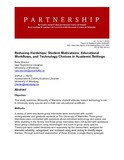| dc.contributor.author | Warren, Ruby | |
| dc.contributor.author | Herter, Joshua J. | |
| dc.date.accessioned | 2020-05-29T18:23:33Z | |
| dc.date.available | 2020-05-29T18:23:33Z | |
| dc.date.issued | 2020-05-28 | |
| dc.identifier.citation | Warren, R., & Herter, J. (2020). Reducing Hardships: Student Motivations, Educational Workflows, and Technology Choices in Academic Settings. Partnership: The Canadian Journal of Library and Information Practice and Research, 15(1). https://doi.org/10.21083/partnership.v15i1.5450 | en_US |
| dc.identifier.issn | 1911-9593 | |
| dc.identifier.uri | http://hdl.handle.net/10680/1801 | |
| dc.description.abstract | Objective – This study examines The University of Manitoba student attitudes toward technology’s role in University study spaces and in their own educational workflows.
Methods - A series of semi-structured group interviews were conducted with current undergraduate and graduate students at The University of Manitoba. Three group interviews were conducted with questions about individual technology and space use while studying in the library, and three group interviews were conducted with questions about group collaboration using technologies and tools in group study spaces. Transcripts were coded iteratively and separately by the researchers, analyzed for interrater reliability, categorized, and reviewed using axial coding to identify major themes. Through continued examination of these themes, a single theory emerged.
Results - The participants expressed a strong need for independence and feelings of control over their workflows, technological tools, and environments. They discussed how interpersonal concerns and anxieties motivated their workflow choices and acknowledged the (often conflicting) motivational forces of personal necessity and personal preference. When examining the motivations behind the selection of technologies and work practices, it became clear that the respondents make technology and workflow decisions in an attempt to minimize their experience of perceived hardships. These perceived hardships could be social, emotional, educational, environmental, or temporal in nature, and the weight of any one hardship on decision making varied according to the individual.
Conclusions - Libraries should be aware of this foundational user motivation and make choices accordingly - identifying and minimizing hardships whenever possible, unless they are necessary to achieve learning or service-specific goals. Additional research is required to help articulate the nuances experienced by particular student demographics. Librarians and future researchers should also consider investigating the potential disconnect between librarian and user attitudes toward technology, the prioritization of user-centered decision-making, and whether or not systematically disadvantaged social groups have different attitudes toward technology and its place in library spaces and academic work. | en_US |
| dc.description.uri | https://journal.lib.uoguelph.ca/index.php/perj/article/view/5450 | en_US |
| dc.language.iso | en | en_US |
| dc.publisher | Partnership: The Canadian Journal of Library and Information Practice and Research | en_US |
| dc.relation.ispartofseries | 15;1 | |
| dc.rights | info:eu-repo/semantics/openAccess | en_US |
| dc.subject | Libraries | en_US |
| dc.subject | User Experience Research | |
| dc.subject | Academic Spaces | |
| dc.subject | Student Motivations | |
| dc.subject | Study Habits | |
| dc.subject | Library As Place | |
| dc.title | Reducing Hardships: Student Motivations, Educational Workflows, and Technology Choices in Academic Settings | en_US |
| dc.type | Article | en_US |
| dc.rights.license | Creative Commons Attribution-NonCommercial-NoDerivatives 4.0 International License | en_US |
| dc.identifier.doi | https://doi.org/10.21083/partnership.v15i1.5450 | en_US |

